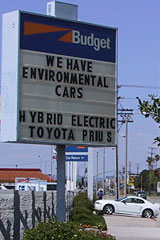
Traffic and Smog
 The Red Line subway in Los Angeles |
Two of the things Los Angeles is most famous for are what the city can be least proud of: epic traffic jams and legendary smog. The two are inextricably tied together, and rooted not only in the Southern California cult of the car, but also in the sprawling nature of suburban land development.
Los Angeles, like many Western cities, once had a streetcar system that connected it's far-flung suburbs, but the old Red Car lines began disappearing after World War II. The last trolley line was discontinued in1961.
 Hybrid cars for rent near the Los Angeles Airport |
Local rail travel is bouncing back in LA, with the completion of 59 miles of subway and light rail in the past 15 years, and another 13 miles to open in the summer of 2003. The Metro Blue Line, from Los Angeles to Long Beach, is the second-busiest light rail line in the country.
Smog, which had grown worse through the fifties and sixties, finally started reversing course in the seventies, when clean air regulations limiting industrial and automobile emissions began to have an effect. Since then, L.A. basin air has improved markedly, with only 49 days in 2002 that didn't meet federal air quality standards, compared to 194 days in 1976. However, it's still the worst in the country.
The South Coast Air Quality Management District, charged with cleaning up Southland air, is trying to combat smog by encouraging cleaner vehicles, while local transit agencies are looking at innovative ways, like the Rapid Bus, to improve public transit.